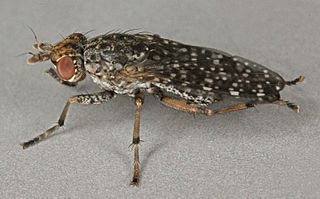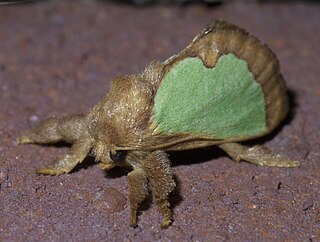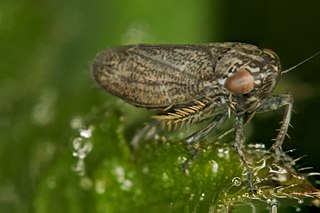
The Integrated Taxonomic Information System (ITIS) is an American partnership of federal agencies designed to provide consistent and reliable information on the taxonomy of biological species. ITIS was originally formed in 1996 as an interagency group within the US federal government, involving several US federal agencies, and has now become an international body, with Canadian and Mexican government agencies participating. The database draws from a large community of taxonomic experts. Primary content staff are housed at the Smithsonian National Museum of Natural History and IT services are provided by a US Geological Survey facility in Denver. The primary focus of ITIS is North American species, but many biological groups exist worldwide and ITIS collaborates with other agencies to increase its global coverage.

Lobosphaera incisa, formerly Parietochloris incisa, is a fresh-water green algae. It is the richest plant source of the PUFA arachidonic acid.
Eumacrodes is a monotypic moth genus in the family Geometridae described by Warren in 1905. Its only species, Eumacrodes yponomeutaria, first described by Achille Guenée in 1858, is found in the Caribbean and North America.

Leucothoe incisa is an amphipod in the family Leucothoidae. It grows up to 7 millimetres (0.28 in) long, and is whitish in colour, but a yellowish green along the back, with intensely red eyes. It lives at depths of up to 60 metres (200 ft) along the Atlantic coast of Europe from the Mediterranean Sea to Scotland, and in the North Sea. It is part of group of sibling species, together with Leucothoe lilljeborgi and Leucothoe occulta.

Dysphania graveolens, common name fetid goosefoot, is a plant found from Utah, Arizona and west Texas to Guatemala, Peru and northwest Argentina. It has been introduced elsewhere including the east coast of the United States. It has many synonyms, including Chenopodium graveolens and Dysphania incisa. In 2021, the correct name in Dysphania was said to be Dysphania graveolens, although as of 12 April 2022, Plants of the World Online accepted the unpublished name Dysphania incisa.

Euclea natalensis, the Natal guarri, is a dioecious African plant species of the family Ebenaceae. It occurs from Ethiopia and Somalia in the north, southwards to the Western Cape, South Africa. It has nectar and also contains pollen Its hirsute, leathery leaves have an opposite arrangement, and the flower sprays grow from the leaf axils. The spherical fruit appear from October to June.

Dictya is a genus of marsh flies in the family Sciomyzidae. There are at least 20 described species in Dictya.
Neofidia clematis is a species of leaf beetle. It is known from southernmost Texas to central Veracruz, Mexico, east of the Sierra Madre Oriental. It was first described by the American entomologist Charles Frederic August Schaeffer in 1904. Two series of this species from Texas were collected from Cissus incisa, a species in the grape family (Vitaceae).
Euclea nanina, the nanina oak-slug moth, is a species of slug caterpillar moth in the family Limacodidae.

Euclea is a genus of moths in the family Limacodidae. The genus was erected by Jacob Hübner in 1819. There are at least 40 described species in Euclea.
Perizoma epictata is a species of moth in the family Geometridae first described by William Barnes and James Halliday McDunnough in 1916. It is found in North America.

Hypera is a genus of clover and alfalfa weevils in the beetle family Curculionidae. There are at least 280 described species in Hypera.

Heterocampa obliqua, the oblique heterocampa or oblique prominent, is a species of moth in the family Notodontidae. It was first described by Alpheus Spring Packard in 1864 and it is found in North America.

Curimopsis is a genus of pill beetles in the family Byrrhidae. There are more than 30 described species in Curimopsis.

Chimarocephala pacifica, known generally as the painted meadow grasshopper or painted grasshopper, is a species of band-winged grasshopper in the family Acrididae. It is found in Central America and North America.

Chaetarthria is a genus of water scavenger beetles in the family Hydrophilidae. There are more than 20 described species in Chaetarthria.
Systropus macer is a species of bee flies. It is a parasitoid of Limacodidae caterpillars, including Adoneta spinuloides, Euclea delphinii, Lithacodes fasciola, Prolimacodes badia, and Parasa indetermina.
Euclea flava is a moth in the family Limacodidae. The species was first described by William Barnes and James Halliday McDunnough in 1910.

Lithoseopsis is a genus of tropical barklice in the family Amphientomidae. There are about 10 described species in Lithoseopsis.

Euscelis incisa is a leafhopper species in the family Cicadellidae. It is found in Europe, North Africa, and Asia. It is formerly known as Euscelis plebejus, among other names.















